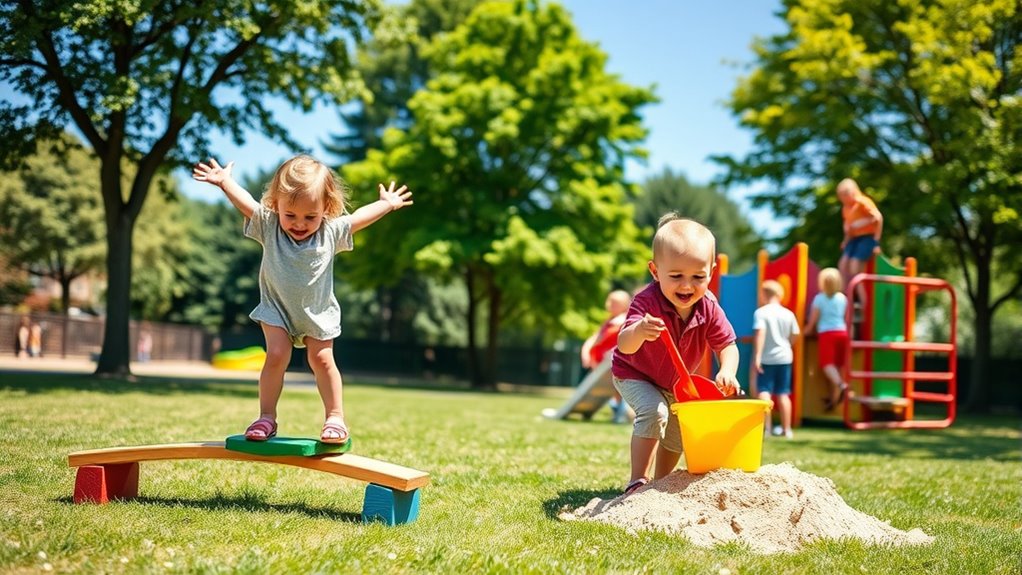To build skills through fun outdoor play, try water activities like sprinklers and water balloons to boost coordination and confidence. Explore nature with scavenger hunts and sensory bins filled with natural items, encouraging curiosity and sensory development. Set up obstacle courses for gross motor skills and let your toddler garden or do construction activities using sand and natural materials. Incorporate music and movement games to promote rhythm and confidence. Keep exploring these ideas to discover more exciting ways to foster your child’s growth outside.
Key Takeaways
- Incorporate water play activities like sprinklers and water balloons to develop motor skills and sensory awareness.
- Use natural items and sensory bins for exploration, fostering observation skills and a love for nature.
- Create obstacle courses and construction zones with sand tools and outdoor equipment to enhance coordination and spatial awareness.
- Engage toddlers in gardening projects, teaching responsibility and fine motor skills through planting and caring for plants.
- Include music and movement games such as musical statues and dance routines to improve rhythm, coordination, and confidence.
Creative Water Play Activities
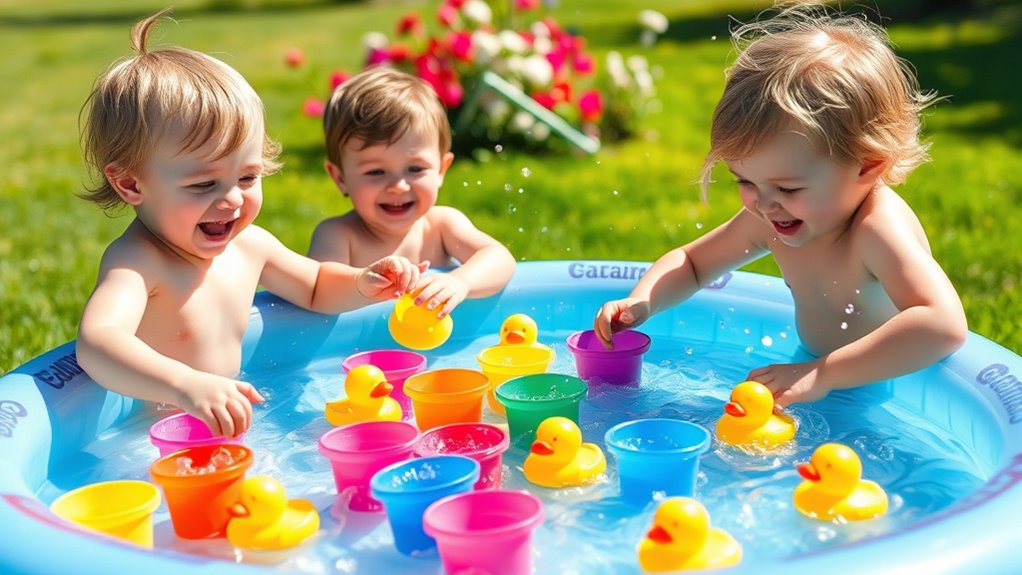
Have you ever noticed how much toddlers love splashing and pouring water? It’s a perfect opportunity to introduce creative water play activities. Fill up colorful water balloons and let your little one enjoy tossing, squeezing, or even popping them. They’ll love the tactile fun and the surprise of the burst! Another great idea is sprinkler fun, where you set up a sprinkler and watch your toddler giggle as they run through the spray. These activities not only keep them cool but also help develop their motor skills and coordination. Water balloons and sprinklers turn simple outdoor spaces into exciting play zones. Plus, your toddler will gain confidence in exploring water safely while having a blast. It’s a simple way to make outdoor play both fun and educational. Transforming your outdoor space with smart outdoor toys can also enhance your child’s play experience while ensuring safety and durability. Additionally, selecting the right outdoor play equipment can support your child’s physical development and provide long-lasting enjoyment. Incorporating age-appropriate outdoor toys can further boost their confidence and skills during outdoor activities.
Nature Scavenger Hunts
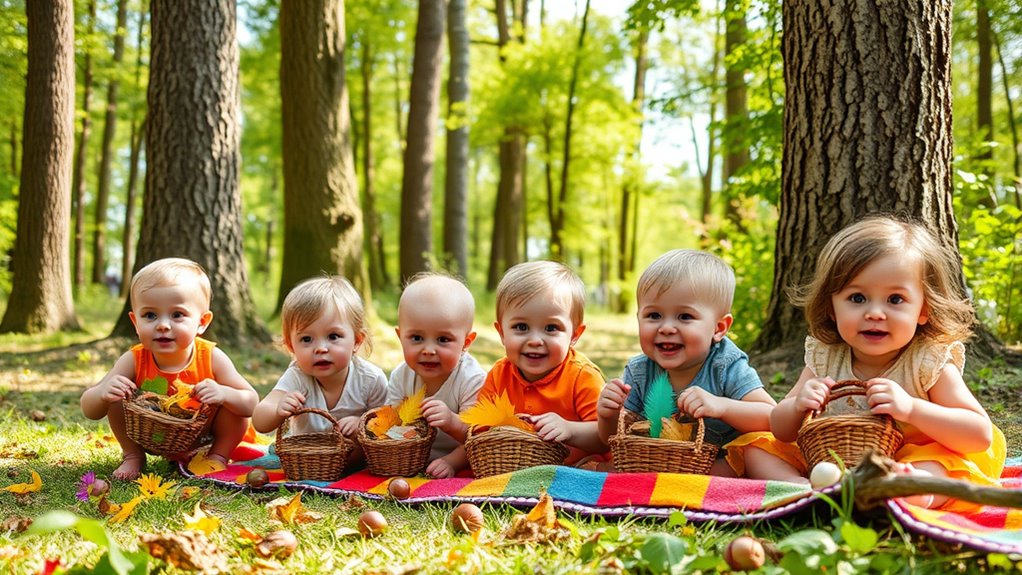
A nature scavenger hunt is a delightful way to get your toddler engaged with the outdoors. It encourages curiosity and promotes skills like leaf collecting and nature journaling. As you explore together, help your child find items such as:
- A colorful leaf
- A smooth pebble
- A flower in bloom
- An interesting stick
Encourage them to observe details, describe textures, and even sketch their findings in a simple nature journal. This activity not only builds observation skills but also fosters an appreciation for nature appreciation. Incorporating visual perception exercises, like identifying colors and shapes, can enhance their understanding of the vibrant outdoors. Keep the hunt fun and relaxed, allowing your toddler to explore at their own pace. When they find each item, talk about its features and what makes it unique. It’s a simple, engaging way to connect with nature and develop early scientific thinking. Understanding the importance of color accuracy in visual perception can also enhance their appreciation of the vibrant outdoors.
Sensory Bins and Outdoor Exploration
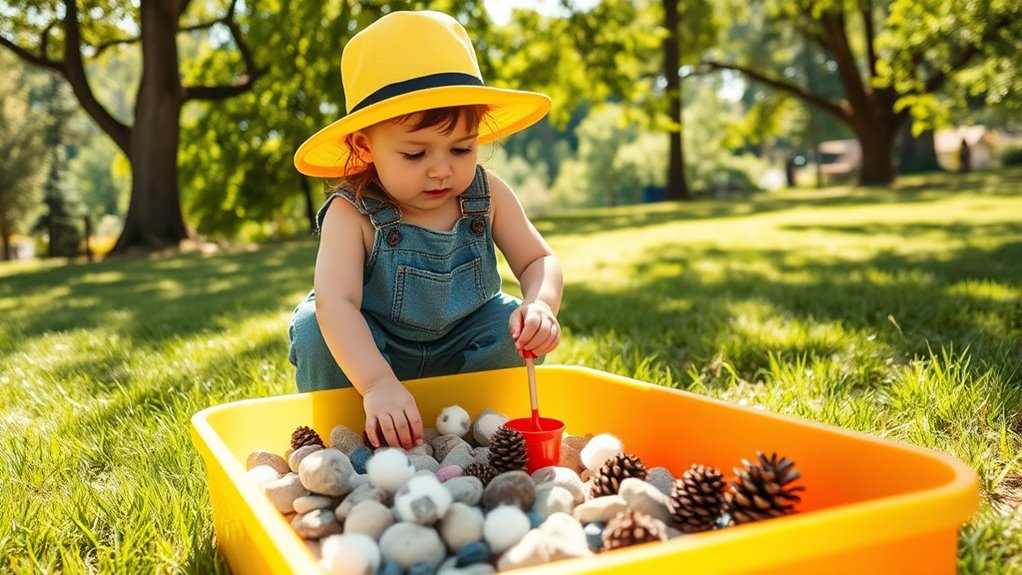
Building on the curiosity sparked by nature scavenger hunts, setting up sensory bins outdoors offers toddlers a hands-on way to explore their environment. Fill bins with natural items like leaves, stones, or sand to stimulate their senses and encourage discovery. You can also incorporate indoor art projects by adding paint, clay, or washable markers for creative expression outside. Sensory bins are perfect for pretend play scenarios, such as pretending to be explorers, bakers, or gardeners, fostering imagination and social skills. Engaging with different textures and materials helps develop fine motor skills while making exploration fun. Incorporating self-watering plant pots into outdoor activities can further teach toddlers about plant care and sustainability, making nature exploration even more educational. Additionally, introducing child-safe gardening tools can enhance their engagement and coordination during outdoor plant care. This approach keeps your toddler actively involved, deepening their understanding of nature and enhancing their creativity through tactile and imaginative play.
Obstacle Courses for Gross Motor Skills
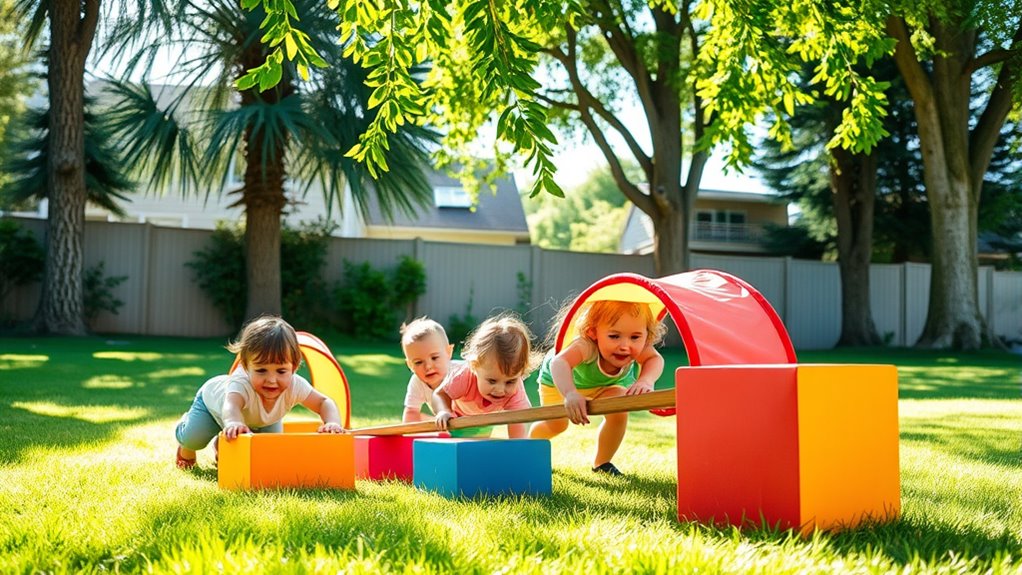
Creating outdoor obstacle courses is a fun and effective way to boost your toddler’s gross motor skills. You can design activities that incorporate balance challenges and agility drills, helping them develop coordination and strength. Here are some ideas to get started:
- Use low beams or a taped line on the ground for balance challenges, encouraging your toddler to walk heel-to-toe.
- Set up cones or objects for agility drills, where they can zigzag or weave through.
- Include crawling tunnels or hoops to promote coordination and muscle development.
- Add hopscotch or jumping stations to enhance jumping skills and overall agility.
- Incorporate safety considerations to ensure activities are secure and age-appropriate, preventing injuries while they play.
- Consider supervision tips to keep your toddler safe and engaged during outdoor play.
Additionally, ensuring proper air purifier maintenance can help create a healthier environment for outdoor activities by reducing airborne pollutants and allergens.
These activities keep your toddler moving, challenge their balance, and improve agility—all while having a blast outdoors.
Gardening and Planting Projects
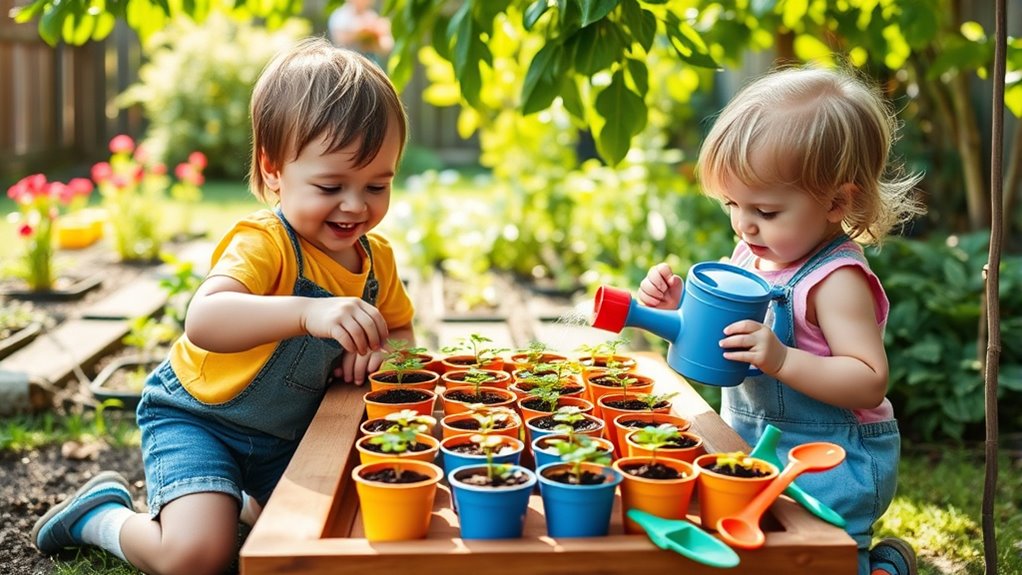
Getting your toddler involved in gardening and planting projects is a wonderful way to foster their curiosity about nature while developing fine motor skills. You can start by teaching them simple garden design concepts, like choosing where to plant flowers or vegetables. Use child-friendly tools so they can dig, scoop, and water with ease. As they learn about plant care, they’ll develop patience and responsibility—watering regularly and watching plants grow. Encourage their creativity by letting them choose colors and types of plants, making the garden a personalized space. Keep activities short and engaging, ensuring they stay interested. This hands-on experience helps build their understanding of nature, promotes sensory exploration, and boosts confidence as they see their efforts turn into a thriving garden. Incorporating interactive learning experiences can further enhance their engagement and understanding of the natural world.
Sandbox and Construction Play
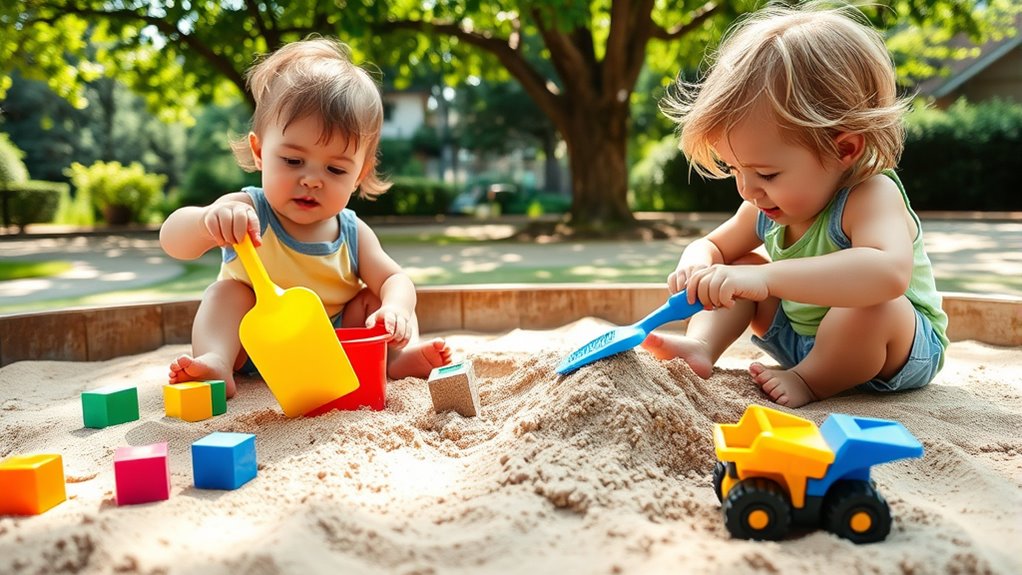
Building with sand tools encourages your toddler to develop fine motor skills and hand-eye coordination. Creative construction challenges inspire problem-solving and imagination during outdoor play. Plus, sensory play with sand offers calming benefits that support your child’s overall development. Incorporating sensory benefits into sand play can further enhance tactile experiences and cognitive growth.
Building With Sand Tools
Using sand tools like shovels, rakes, and buckets turns a simple sandbox into a dynamic construction zone. These tools help your toddler develop fine motor skills while exploring creative ways to build. For added fun, encourage activities like clay modeling with damp sand or creating colorful chalk art on nearby surfaces. Here are four ways to enhance play:
- Dig and transport sand with shovels and buckets.
- Rake patterns or build walls and tunnels.
- Mold shapes or figures using clay-like textured sand.
- Draw vibrant chalk art around the sandbox to inspire artistic expression.
Additionally, introducing natural materials such as sticks or rocks can expand your child’s creative possibilities in the sandbox, encouraging problem-solving and sensory exploration. Incorporating sensory play by mixing different textures like water or pebbles can further enhance their tactile experience. This combination of construction and artistic play boosts coordination, imagination, and problem-solving—all through engaging, hands-on activities.
Creative Construction Challenges
Transforming simple sand tools into creative construction challenges sparks your toddler’s imagination and problem-solving skills. You can encourage them to build bridges, towers, or roads using buckets, shovels, and molds, turning the sandbox into a mini construction site. These outdoor activities promote fine motor skills and spatial awareness. For added variety, explore indoor construction activities on rainy days or when outdoor play isn’t possible, like stacking blocks or assembling foam bricks. Digital building games also complement hands-on play by introducing new design concepts and problem-solving in a fun, interactive way. Incorporating water parks into your child’s outdoor play routine can also provide refreshing opportunities for water-based construction activities, enhancing their sensory experiences and coordination. Combining physical sandbox challenges with digital options provides a well-rounded approach to building skills while keeping your toddler engaged and inspired to create.
Sensory Play Benefits
Engaging your toddler in sandbox and construction play offers numerous sensory benefits that support their development. These activities enhance tactile textures, helping your child differentiate between rough, smooth, and gritty surfaces. They also promote sensory integration, allowing your child to process multiple sensory inputs simultaneously.
Here are four key benefits:
- Improves fine motor skills as they scoop, pour, and build.
- Stimulates tactile exploration through various textures.
- Enhances focus and concentration during creative play.
- Builds spatial awareness through stacking and constructing.
Musical Movement and Dance Games
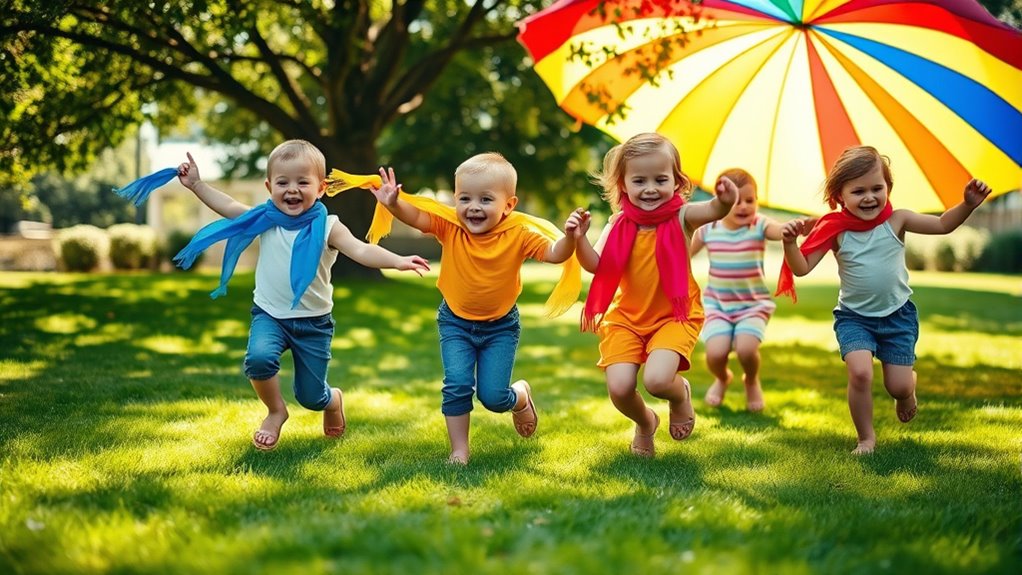
Musical movement and dance games are fantastic ways to get toddlers active and excited outdoors. These activities encourage rhythmic movement, helping children develop coordination and a sense of timing. Play simple games like musical statues, where they freeze when the music stops, or follow-the-leader dance routines that promote movement awareness. You can also introduce dance improvisation, encouraging toddlers to express themselves freely through movement to lively music. This fosters creativity and boosts confidence as they explore different ways to move their bodies. Incorporating musical beats and encouraging spontaneous dance helps children build a connection between rhythm and physical activity. Plus, these games are fun, engaging, and perfect for developing motor skills while enjoying the fresh air.
Frequently Asked Questions
How Can Outdoor Play Support a Toddler’s Emotional Development?
Outdoor play helps your toddler develop emotional resilience by allowing them to face challenges and manage feelings in a safe environment. It also boosts social confidence as they interact with peers, share toys, and navigate group activities. You support this growth by encouraging exploration and praising efforts, which helps your toddler feel more secure and confident. This active engagement fosters emotional strength and helps them build healthy relationships.
What Safety Precautions Are Essential During Outdoor Activities?
You should always follow supervision guidelines to keep your toddler safe during outdoor activities. Keep a close eye on them, especially around water, uneven surfaces, or sharp objects. Prevent hazards by inspecting the play area regularly, removing any dangerous debris, and ensuring equipment is secure. Using age-appropriate toys and setting clear boundaries also helps minimize risks, so your little one can enjoy outdoor fun safely and confidently.
How Can Parents Encourage Sharing During Outdoor Play?
Think of outdoor play as planting seeds of friendship. You can encourage sharing by modeling sharing behaviors yourself and using sharing strategies like taking turns and offering gentle reminders. Praise your toddler when they show cooperation, reinforcing positive actions. Creating opportunities for collaborative play, like group games, helps them learn the value of sharing naturally. Your consistent encouragement nurtures their social skills, helping them develop into compassionate, cooperative friends.
Are There Activities Suitable for Toddlers With Limited Mobility?
Yes, you can include adaptive activities for toddlers with limited mobility to promote inclusive play. Try activities like sensory bins, water tables, or lightweight balls that can be easily reached or manipulated. Use ramps or mats to create accessible spaces. These adaptive activities allow your little one to participate actively, helping them develop skills while enjoying outdoor play alongside peers. Inclusive play fosters joy and learning for every child.
How Can Outdoor Play Be Adapted for Different Weather Conditions?
You can adapt outdoor play for different weather conditions by incorporating weather adaptation strategies and seasonal activities. On hot days, plan shade and water play to keep your toddler cool and hydrated. During rainy weather, set up covered areas or indoor play options nearby. In winter, bundle up your toddler and explore snow-themed activities. These adjustments make certain of safe, fun outdoor experiences year-round, fostering skill development in all seasons.
Conclusion
As you embrace outdoor play, you’re nurturing more than just skills—you’re planting seeds of curiosity and confidence that will grow with your child. Each activity becomes a stepping stone on their journey of discovery, symbolizing the endless possibilities that nature and imagination offer. By encouraging these joyful adventures, you’re helping your toddler develop a strong foundation for lifelong learning, resilience, and wonder—reminding them that every new experience is a chance to bloom.
